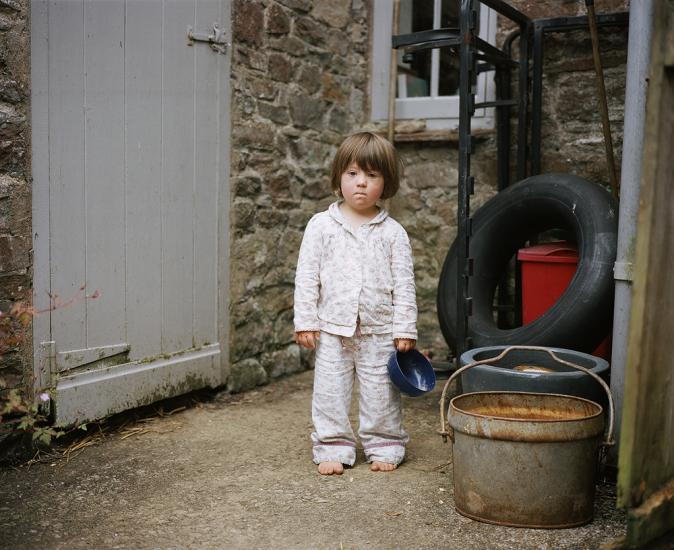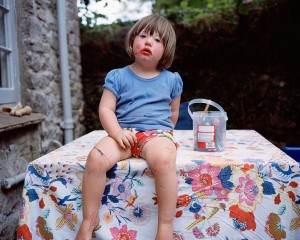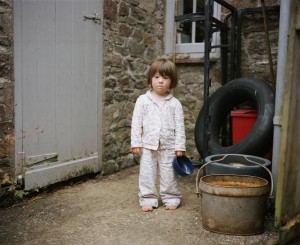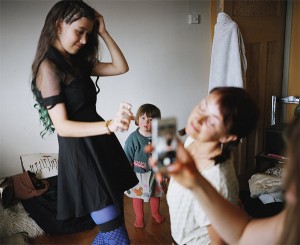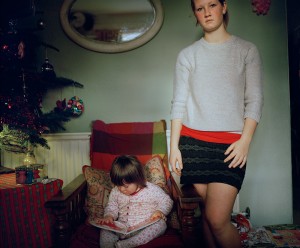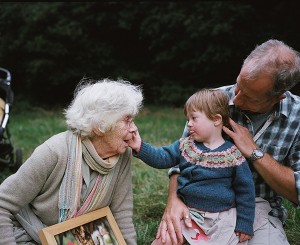BY DAVID CHANDLER
During the 1980s, as the domestic realm increasingly became one of its primary subjects, photographic art began to add a new critical dimension to what experience had already seared into the core of our collective being: that the models of family life propagated by advertising and the media, were, on almost every level, a lame and often surreal fiction. Oddly, perhaps, it was our own amateurish attempts to put a gloss on reality, the vernacular family snapshot, that provided a template for the images of this new art.
Predicated on the recording, and creation, of coherence and blissful unity – happy moments, celebrations, instances that spoke of aspired-to ideals, and a kind of perfection having been briefly attained – the snapshot always had its flip side: those lapses of attention, and time, the strange moments in-between, where figurative disarray, loose expressions and maniacal gestures called forth another reality, one of disunity and psychological tension.
It was the confluence of these two sides of the snapshot – immediate, celebratory/discordant, subversive – that so mesmerized the American photographer William Eggleston as he watched endless strips of colour snaps roll from a developing machine at an industrial photofinishing lab in Memphis during the mid-sixties.
His subsequent recalibration of what the art of photography could be unlocked the potential of the everyday for a new generation of photographers, and proposed the simple idea, long explored by writers, that the very specific conditions of those local, private and even insular worlds could also be powerfully indicative microcosms of an increasingly homogenized contemporary experience. Eggleston suggested, too, a new model of photographic practice in which the questing traveller/reporter might be legitimately replaced by a stay-at-home insider, someone content to be immersed in the ordinary, whose urgent social battleground was territorially defined not by international borders but by a garden fence.
In a sense Eggleston’s work helped to usher in a new orthodoxy in the photographic representation of the domestic scene, one pitted firmly against those media stereotypes and linked by a preference for informality, irony and the uncanny; it was a kind of multifaceted classicism, in which the awkward, jarring textures of life as lived, achieved an alternately raw and statuesque grace.
The legacy of this extensive body of work has been a fertile context for Sian Davey. It has intensified the lure of photographic images for a woman who had already practised for fifteen years as a psychotherapist; suggesting richly nuanced ways in which her own, already exceptional, pictures of family and friends might find a more common connection with some of the ideas that informed her professional work.
Photography helped Sian to turn inward, not as another form of therapy, but simply as a new way of seeing and exploring the interpersonal dynamics of her own life; to recognise, appreciate and help understand them more clearly. Her projects (and, in a sense, they are all one project) are clearly motivated by the complexity of human relationships, and the frail yearnings and struggles of people who share their lives together.
She has quickly refined what seems to be something of an inherent ability to make pictures that figuratively articulate a profound sense of the shifting psychological pressures that a family accommodates and carries with it, like a loosely assembled human caravan lumbering through time.
But the core of this work, and the core of her family, is represented by the photographs gathered together in this book, that are an intimate account, and a searching reflection, on the early life of Sian’s daughter Alice, who was born with Down’s syndrome in 2009.
In his short essay “Against Distraction”, the writer and psychotherapist Adam Phillips suggests that because they are so heavily photographed, children’s lives are now ‘a continual apprenticeship in observation, in the vigilance of attention…and whether or not this attention is concerned it is always intent, a spelling out of the adult’s obscure desire’.
And so for the child, Phillips says, ‘there is always…the puzzle of what the adult might be wanting; the wish to comply and the wish to do whatever else might be possible, in the face of such riveting demand. It would not be surprising to discover that the child experienced the whole situation as vaguely sacrificial.’
Sian Davey has said that photographing Alice was motivated by a sense of post-natal confusion, and that as well as fulfilling the common desire to chronicle a child’s life, the pictures manifest a need to ‘find’ and to understand a daughter who, as she has said, ‘did not feel like any other children.’ Sian’s title for the book, Looking For Alice, is quite literal in this respect. And, importantly, the images embody a more ‘obscure desire’, to map and give tangible expression to a mother’s love that was, from the moment Alice was born, complex and dislocated.
Yet if these photographs were given impetus by what Sian has called her own ‘fear and uncertainty’, they are also about the ways in which Alice has gradually quelled and resolved those amorphous feelings. And in this sense the photographs build into a record of an innate and unconditional love in the process of flowering.
Like those magical adventures, the title Looking for Alice so consciously echoes, Sian’s pictures document a journey, one that is psychological and emotional, but also physical: the view or passage out of the protected, cradling space of the family – out of a window, along a path, through a gate, with all the intimations of the future they bring – being consistently invoked.
And the future is seeded, too, in other ways. The photograph in which Alice is mesmerised by the sight of older girls getting ready for a party, along with their obligatory photographing of themselves on a mobile phone, is infused with the quizzical sense (and it is our question not hers) of what the future holds for her.
This is even more strongly felt, perhaps, in the Christmas portrait of Alice and her elder sister Martha, where the child with the book, her immersion in a world of myriad distractions, is held in such stark contrast to Martha’s self-conscious posing – as Phillips says, at the moment ‘when who one is starts turning into who one might want to be’ – and where the young woman’s returning of her step-mother’s gaze, so apparently imbued with that question about ‘what the adult might be wanting’, has such incredible poignancy.
It is the tension between the ‘vigilance of attention’ she undergoes, and Alice’s complete lack of self-conscious posing – the wonder and curiosity of her look, into and away from the camera lens – that gives the photographs in this book their particular sense of openness and intimacy for the viewer; the intense sentiment that is never sentimental – Alice’s presence being so free from, so incapable of, what Phillips calls ‘the kitsch sentimentality children learn to protect themselves with’.
Yet these pictures of Alice also follow a familiar pattern: they capture childhood scenes that we might all recognise, and to an extent Sian’s work replays all those hastily photographed instances when we like to think that the true nature of our child has been momentarily unveiled; both determinedly individual, ‘so like her’, and reassuringly childlike, ‘so typical’. For Alice’s experiences, her responses to the world are like those of any other child: the rapt attention, the willfulness, the impenetrable vacancy or reverie, the disconsolate moments, the inconsolable distress.
And there is something of a picture-book quality to the way these image-narratives are strung together in the book; the jumble of one child’s life folding into another gilded story of innocence and discovery. Like those stories, Looking For Alice is a constructed narrative and an obviously partial account of what happened during the period in which the photographs were made; a set of symbols that represents both Alice’s life and her mother’s reaching out through apprehension and fear.
But what makes the book unique, a completely separate story, is that it is also about the reconciling of difference: for Sian, for her family who occasionally share Alice’s stage and are present throughout as the photographer’s fellow observers, and in relation to the pre-conceptions of most of the book’s reader/viewers.
Like Alice’s grandmother who is caught suddenly open-mouthed at the extraordinary tenderness of the child’s touch, at her small benediction, these photographs continually test our expectations, expose our ignorance, our lack of experience, and ask us to think again.
In posing these questions, Sian’s photographs do not ignore the complexity of difference, and, like the light that glows and fades through the book, the evidence of Alice’s vigour is continually balanced by reminders of her vulnerability, and by the sense that, in part, she remains fugitive to the search that the images so ardently conduct.
And neither does the book seek to compromise the feeling that this dialogue between a mother and daughter is so personal, so intensely private, that perhaps we shouldn’t being seeing it at all, that we are intruding on and attempting to grasp something that we can never fully comprehend. The book’s openness, its disarming honesty, is further freighted with the tension arising from its photographs being exposed to public scrutiny, with Alice’s most intimate life at its very centre.
But this is a story that Sian felt compelled to tell, to chart her own experience as the fog cleared around her love; to summon that love’s full emotional range, and to offer the abiding portrait of Alice, her own daughter, as a powerfully positive response to the social stigma attached to Down’s syndrome. It has been Sian’s discovery, and now her firm conviction, that she can tell this story most eloquently through photographs, whose nuanced signs so often surprise us and continue to resist translation into words.
If the overarching lesson of domestic imagery in contemporary photographic art is that families are largely dysfunctional and constitute a locus of struggle rather than one of natural cohesion, then Looking For Alice, unusually, presents something of an alternative and sobering picture.
Reflecting only open-hearted acceptance, Alice has become the emotional point of confluence for this family and her image as it shifts through these photographs in some ways represents them all, she is the redemptive mirror in which they have learned to see themselves more clearly.
About the author:
David Chandler is Professor in Photography at Plymouth University. His research interests focus on British and American photography of the post-war era, and particularly on contemporary practice. His essays have recently been published in: Ori Gersht: History Reflecting (Museum of Fine Arts Boston, 2015); Bettina von Zwehl: Made Up Love Song (Victoria and Albert Museum, 2015); Anna Fox: Resort 2 (Schilt Publishing, 2015); Paul Graham: The Whiteness of The Whale (Pier 24/MACK Books, 2016); Thom and Beth Atkinson: Missing Buildings (Hawaet Books, 2016); Nigel Shafran: Dark Rooms (MACK Books, 2016); and Strange and Familiar: Britain as Revealed by International Photographers (Prestel Publishing/Barbican Art Gallery, 2016).

